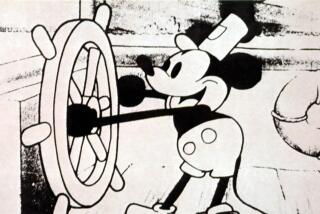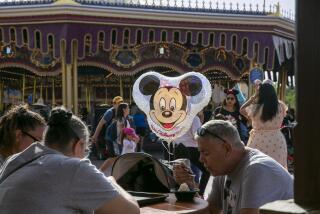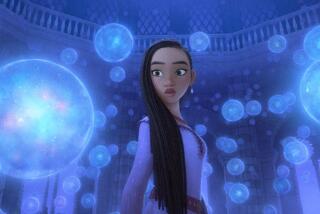Pooh’s Pot of Gold
- Share via
At the center of things is the bear. Edward Bear. A.k.a. Winnie-the-Pooh. A small bear, of very little brain, with a sticky substance abuse problem, and yet a certain charisma. He gathered about him a clan of disparate creatures--a piglet, a donkey, a rabbit, two kangaroos, an owl. The purpose: adventure. They all ostensibly answered to the Man, the Big Guy in short pants, Christopher Robin, but it was the bear who called the shots. In his own rum-tum-tiddle-um-tum way, he ran the Hundred Acre Wood.
But that wasn’t enough. It’s never enough. Eventually, he’d cut a deal. Eventually, he headed to the Coast. On Uncle Walt’s dime. And now?
Forget the mouse. The bear owns this town.
A trip through any toy store, any department store, tells the tale. Or at least the licensing / copyrighting of a tale. Where once there was nothing, or but a few plush toy Poohs, slightly orange with the red monikered crop top, there are now racks of Pooh, walls of Pooh, rooms of Pooh. And Piglet, and Tigger and all the denizens of the wooded acres that grew within A.A. Milne’s imagination.
There are dolls and toys and games, bedding and clothes and chairs, watches and earrings and backpacks, pillows and throw rugs and piggy banks, soap dispensers and toothbrush holders and personal hygiene products. Most of which come in two guises--Pooh, the vivid Disney drawn characterization, and the more sedate and traditional Classic Pooh.
And these days there are, despite the nondenominational nature of the original characters, Santa Pooh gift bags, tags and paper, Christmas stockings, Christmas throws and more ornaments than you could fit on the Rockefeller Center tree. There’s even the Hanukkah Party Pooh.
Surely, Ramadan Pooh and Kwanzaa Pooh are not far behind.
“Pooh belongs to everybody,” says John Singh, spokesman for the Disney Consumer Products Division. “He can be anything you want him to be. It’s totally appropriate for him to celebrate Thanksgiving or Hanukkah or the Fourth of July.”
That’s a lot to expect from a British citizen well into his 70s. Endure the Fourth of July perhaps. But celebrate it?
*
The Mouse Is Down for the Count
The numbers say no matter what Pooh does, he does it big. In October, Winnie-the-Pooh was the No. 2 licensed toy line, behind only Barbie. Ed Roth at the NPD Group, a marketing research firm in New York, says he expects it will finish in the top five at year’s end--the first year it would do so--with such heavy hitters as Hot Wheels and Lego.
“It’ll probably end up with 2% or 2.2% of the market,” Roth says. “That may sound small, but it translates to about $400 million. And that’s just the toys.”
Where do Disney’s standard characters rank? No. 16. Which explains why the next new ride at Disneyland, scheduled to open next summer, will be the Many Adventures of Winnie-the-Pooh. Which explains why there are whispers among those who know that the bear, in fact, has replaced the mouse, that the mouse is down for the count.
How did a mild-mannered literary bear and his friends, plucked from the sylvan simplicity of the English countryside, manage to invade the shelf space of seasoned industry pros like Big Bird and Mickey?
“Pooh is a very lovable character,” says Charles Riotto, executive director of the Licensing Industry Merchandising Assn. “He’s soft and cuddly, which parents are attracted to. And many mothers today grew up with him, so you’ve got the nostalgia factor. And, of course, the property managers have done a terrific job.”
The property managers are, of course, Disney. And their courtship of Winnie-the-Pooh and his friends was a persistent one, beginning sometime in the 1940s when, according to Robert Tieman, manager of the Walt Disney archives, Walt himself began sporadic negotiations with the A.A. Milne estate. It was complicated--Dutton Publishing owned some rights, as did Milne’s widow and his gentlemen’s club, so it wasn’t until 1964 that Disney was able to acquire film and merchandising.
The first thing Disney did was redraw Ernest H. Shepard’s pen-and-ink characters in a more child-friendly and colorful way. The second thing was to grant Sears, then Sears, Roebuck & Co., 30-year exclusive merchandising rights. Originally, Walt had planned to make a full-length Pooh movie, but because of story problems--the books are episodic rather than narrative--and Walt’s fear that Americans weren’t familiar enough with the tales, he decided to make a series of featurettes, which debuted in 1966 with “Winnie-the-Pooh and the Honey Tree.” Narrated by Sebastian Cabot with the furry-voiced Sterling Holloway as the bear in question, these films introduced a generation to the heffalump-hunting, bee-tree raiding, umbrella-riding creatures.
In the meantime, Sears had gone ahead with a line of plush toys and pajamas, making Winnie-the-Pooh the first Disney character for which the merchandise preceded the film.
Thirty years later, when the contract was up, things at Disney had changed a bit. The company was doing its own merchandising and was looking for another 365-day product, something with the punch and durability of Mickey and friends.
*
Disney Pooh for Kids, Classic Pooh for Adults
Enter the bear. And all his little friends. The treehouses and honey pots. Which would look so good on mobiles and lunch boxes and cookie jars and blankets. . . .
Disney did not renew the Pooh contract with Sears.
Instead, Disney began planning the return of Winnie-the-Pooh, both Disney and Classic. The former was aimed at mass market, preteen middle America; the latter, which had been licensed since the late ‘80s to a few high-end manufacturers, remained premium, more for adults than preschoolers.
The launch, intentionally, was not tied to any movie or event. The Disney logo, though present, is downplayed on Pooh merchandise and is almost invisible on Classic Pooh. Working with a wide variety of licensees--Mattel, Timex, Johnson & Johnson, Wamsutta--Disney created products across all categories. All, says Singh, true to the original themes of Milne’s work.
“All our licensees are well-versed in the characters,” Singh says. “We make them well-versed,” he adds, describing the Pooh style guide, which devotes several hundred pages to each character. “It’s the definitive source on history, appearance, coloring, personality, down to what they like to eat, drink, do for fun. . . .”
*
Disney Characters Not Quite Like A.A. Milne’s
Pooh purists might argue with this. There is an unflagging vivaciousness of the characters’ depictions not present in the books--Tigger was irrepressible, certainly, but the others were not exactly vivacious. They had more complex personalities that included swirls of timidity (Piglet), arrogance (Owl), seemingly chemical depression (Eeyore), xenophobia (Rabbit) and maternal oppression (Kanga).
And Disney’s creation of very un-Milne story lines--for the TV show “The New Adventures of Pooh,” which is currently in reruns and has, of course, accompanying videos and children’s books--leave some confused or dismayed.
“My husband was looking at the kids’ books,” one mother of two says. “And he got pretty angry. He said, ‘This never happened in the real books, this wouldn’t have happened in the real books.’ ”
At Dutton Children’s Books, which still owns the rights to the original Milne classics, there is no such animal as Classic Pooh. There is Pooh and “the Other Pooh.”
But Disney is not alone in testing the elasticity of the characters. There is also the “Tao of Pooh” and “The Te of Piglet” by Benjamin Hoff, which explore the Eastern mystical symbolism of Milne’s work in a bestselling sort of way.
Yet the naysayers and the mystics cannot dispel the fact that since 1995, when Mattel came out with the first new Pooh plush toys, the success has been phenomenal.
Because at the center of the numbers and the strategy is the bear. Perpetually perplexed but game for just about anything, he is our alter ego. Never too busy for a game of sticks or a morsel of honey, he and his friends can be counted on. “They’re cute and cuddly,” says Lindsay Jorden, a 12-year-old Pooh aficionado. “And when you need a friend, Pooh’s there to play with and to hug.”
He is, after all, that sort of bear.
More to Read
Sign up for The Wild
We’ll help you find the best places to hike, bike and run, as well as the perfect silent spots for meditation and yoga.
You may occasionally receive promotional content from the Los Angeles Times.







